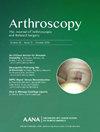髋关节外旋可减少股骨髁间距:尸体研究与透视研究之间的正相关性
IF 4.4
1区 医学
Q1 ORTHOPEDICS
Arthroscopy-The Journal of Arthroscopic and Related Surgery
Pub Date : 2025-02-01
DOI:10.1016/j.arthro.2024.03.038
引用次数: 0
摘要
目的:确定髋关节外旋或外展/内收对最小化髋股关节间距(IFD)的影响,并评估不同髋关节位置下尸体和透视 IFD 测量值之间的相关性:这项尸体研究涉及来自 17 具防腐尸体的 33 个髋关节。IFD是小转子和外侧楔骨之间的距离,在不同的髋关节位置进行测量:中立位、外旋 30°、外旋 60°、髋关节中立伸展和内收以及髋关节伸展 10°和内收 10°。分析了不同体位下 IFD 的差异以及尸体和透视测量的相关性:IFD测量结果显示,髋关节外旋60°时IFD下降幅度最大,仅在尸体组的中立位和外旋60°之间观察到显著差异(7.60±4.68 vs 5.05±3.48,95% CI,0.14~4.96;P=0.036)。在伸展和内收位置之间没有观察到实质性差异。尸体测量值与透视测量值之间呈正相关,尤其是在中立位(r=0.492,p=0.004)、外旋30°(r=0.52,p=0.002)、外旋60°(r=0.419,p=0.015)以及伸展/内收位结合中立位旋转(r=0.396,p=0.023)时:结论:随着髋关节外旋角度的增加,IFD明显下降,尤其是在60°时。结论:随着髋关节外旋角度的增加,IFD明显下降,尤其是在60°时,而在伸展/内收位置则没有观察到明显下降。此外,在特定髋关节位置的尸体测量和透视测量之间也观察到了正相关性:中性旋转、30°和60°的外旋以及10°的伸展/内收与中性旋转:外科医生可以利用这些知识,通过X光检查改进髋关节撞击评估,重点关注IFD减少最明显的位置。了解髋关节位置与 IFD 之间的关系可提高对髋股关节撞击综合征的诊断,有利于患者护理和治疗效果。本文章由计算机程序翻译,如有差异,请以英文原文为准。
Hip External Rotation Decreases Ischiofemoral Distance: A Positive Correlation Between Cadaveric and Fluoroscopic Studies
Purpose
To determine the effect of hip external rotation or extension/adduction on minimizing the ischiofemoral distance (IFD) and assess the correlation between cadaveric and fluoroscopic IFD measurements in different hip positions.
Methods
This cadaveric study involved 33 hip joints from 17 embalmed cadavers. IFD, the distance between the lesser trochanter and lateral ischium, was measured in different hip positions: neutral, external rotation at 30°, and external rotation at 60° with the hip in both neutral extension and adduction as well as 10° hip extension and 10° hip adduction. Differences in IFD related to positions and correlation between cadaveric and fluoroscopic measurements were analyzed.
Results
IFD measurements showed that the greatest reduction occurred at 60° of external hip rotation, with a significant difference observed only between neutral and 60° external rotation in cadaveric groups (7.60 ± 4.68 vs 5.05 ± 3.48, 95% CI, 0.14-4.96; P = .036). No substantial difference was observed between the extension and adduction positions. Positive correlations were observed between cadaveric and fluoroscopic measurements, especially in the neutral position (r = 0.492, P = .004), external rotation at 30° (r = 0.52, P = .002), external rotation at 60° (r = 0.419, P = .015), and the extension/adduction positions combined with neutral rotation (r = 0.396, P = .023).
Conclusions
The IFD significantly decreased with increasing degrees of hip external rotation, particularly at 60°. No significant reduction was observed in the extension/adduction positions. In addition, positive correlations were observed between cadaveric and fluoroscopic measurements for specific hip positions: neutral rotation, external rotation at 30° and 60°, and extension/adduction at 10° with neutral rotation.
Clinical Relevance
Surgeons can use this knowledge to improve hip impingement assessment through radiography, focusing on positions in which IFD reduction is most notable. Understanding the relationship between hip positions and IFD can enhance the diagnosis of ischiofemoral impingement syndrome and benefit patient care and outcomes.
求助全文
通过发布文献求助,成功后即可免费获取论文全文。
去求助
来源期刊
CiteScore
9.30
自引率
17.00%
发文量
555
审稿时长
58 days
期刊介绍:
Nowhere is minimally invasive surgery explained better than in Arthroscopy, the leading peer-reviewed journal in the field. Every issue enables you to put into perspective the usefulness of the various emerging arthroscopic techniques. The advantages and disadvantages of these methods -- along with their applications in various situations -- are discussed in relation to their efficiency, efficacy and cost benefit. As a special incentive, paid subscribers also receive access to the journal expanded website.

 求助内容:
求助内容: 应助结果提醒方式:
应助结果提醒方式:


